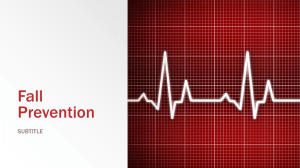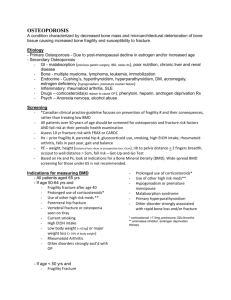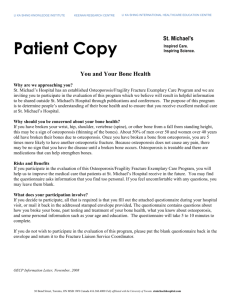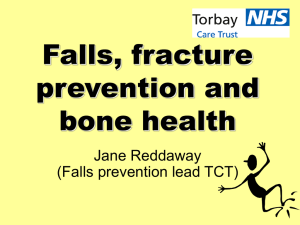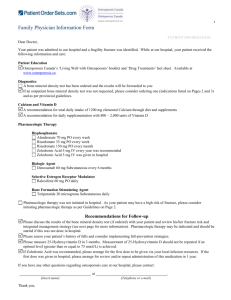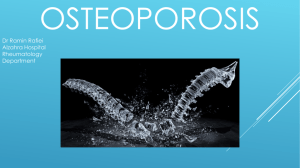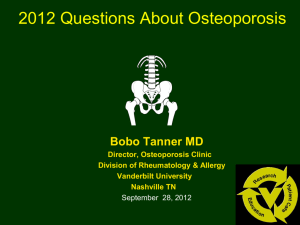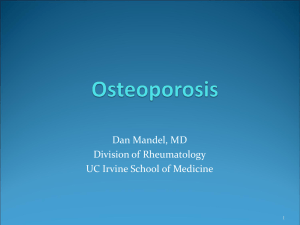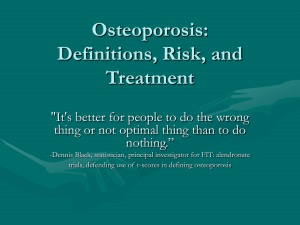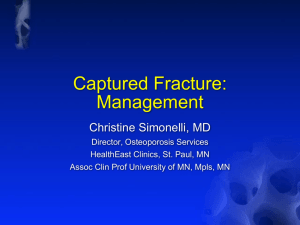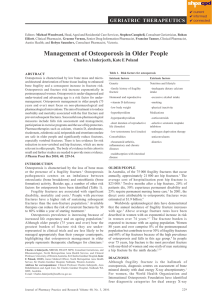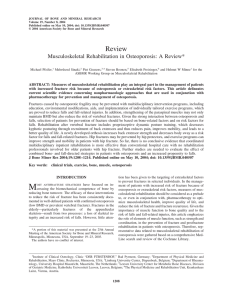Osteoporosis
advertisement
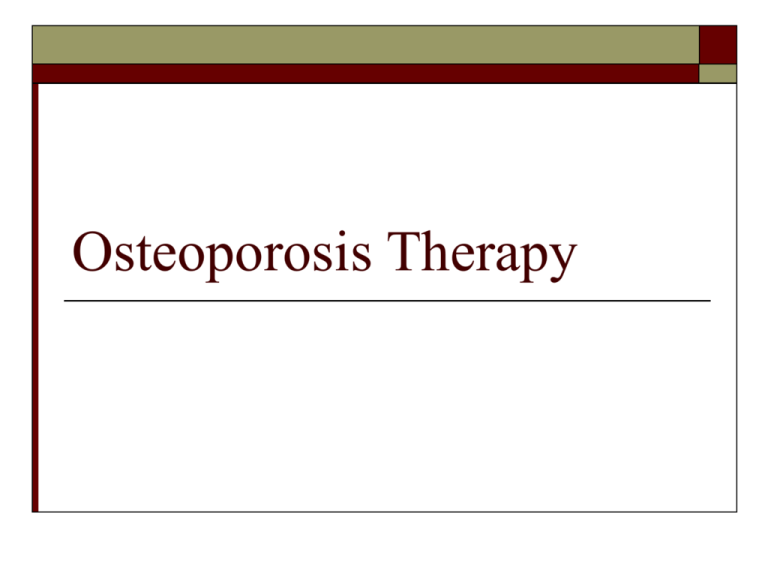
Osteoporosis Therapy Osteoporosis Treatment: Calcium and Vitamin D Fewer than half adults take recommended amounts Higher risk: malabsorption, renal disease, liver disease Calcium and vit D supplementation shown to decrease risk of hip fracture in older adults 1000 mg/day standard; 1500 mg/day in postmenopausal women/osteoporosis Vitamin D (25 and 1,25): 400 IU day at least; Frail older patients with limited sun exposure may need up to 800 IU/day Osteoporosis Treatment: Calcitonin Likely not as effective as bisphosphonates 200 IU nasally/day (alternating nares) Decrease pain with acute vertebral compression fracture Osteoporosis Treatment: Bisphosphonates Decrease bone resorption Multiple studies demonstrate decrease in hip and vertebral fractures Alendronate, risodronate IV: pamidronate, zolendronate (usually used for hypercalcemia of malignancy, malignancy related fractures, and multiple myeloma related osteopenia) Ibandronate (boniva): once/month Those at highest risk of fracture (pre-existing vertebral fractures) had greatest benefit with treatment Bisphosphonate Associated Osteonecrosis (BON) Jaw osteonecrosis Underlying significant dental disease Usually associated with IV formulations Case reports associated with oral formulations Bisphosphonates: Contraindications Renal failure Esophageal erosions GERD, benign strictures, most benign GI problems are NOT a contraindication Concern for esophageal irritation/erosions from direct irritation, recommendations to drink water after and not lie down at least 30 minutes Reality: no increased GI side effects compared to placebo group in multiple studies Osteoporosis Treatment: Estrogen Replacement Reduction in bone resorption Proven benefits in treatment FDA approval, now limited because of recent concerns from HERS trial and other data suggesting possible increased total risks with HRT (?increased cardiac risk, increased risk VTE, increased risk cancer) Osteoporosis Treatment: Selective Estrogen Receptor Modulators Raloxifene FDA recommended Decrease bone resorption like estrogen No increased risk cancer (decrease risk breast cancer) Increase in vasomotor symptoms associated with menopause Osteoporosis Treatment: PTH Teriparatide Why PTH when well known association with hyperparathyroidism and osteoporosis??? INTERMITTENT PTH: overall improvement in bone density Optimal bone strength relies upon balance between bone breakdown and bone build up; studies with increased density but increased fracture risk/fragility with flouride show that just building up bone is not enough!!! Intermittent PTH: Teriparatide Studies suggest improved BMD and decreased fractures ?risk osteosarcoma with prolonged use (over 2 years): studies with rats SQ, expensive Option for severe osteoporosis, those on bisphophonates for 7-10 years, those who can not tolerate oral bisphosphonate Optimal effect requires bone uptake Not for use in combination with Bisphosphonate! May need to stop bisphosphonate up to 1 year prior Reducing Fractures 1. Decrease osteoporosis/improve BMD 2. Decrease risk of break: hip protectors 3. Decrease risk of fall Hip Protectors Padding that fits under clothing Multiple studies demonstrate effectiveness at preventing hip fractures Likely cost effective Problem: adherence! Falls Reduction Falls are a marker of frailty Hip fracture is a marker of frailty Mortality after hip fracture:?due to hip fracture or hip fracture as marker for those who are declining? Increased risk of falls: Prior fall (fear of falling) Cognitive decline Loss of vision Peripheral neuropathy Weakness Stroke Medications: anticholinergics, tcas, benzos… ETOH Current Guidelines US Preventive Task Force Test Bone Mineral Density in all women over age 65, younger postmenopausal women with at least one risk factor, and postmenopausal women with a history of fracture Treat patients with T score <-2 and no risk factors, T score <1.5 if any risk factors, and anyone with prior vertebral/hip fracture Who is left out? Older men Not included in recommendations Screening not recommended or paid for Significant problem, risk of osteoporosis, risk of fracture, especially after age 70, even more so after age 80 Significant evidence that men with osteoporosis benefit from treatment


